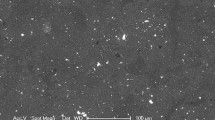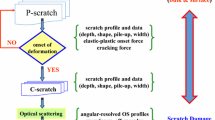Abstract
Acrylic-melamine coatings are known to be susceptible to hydrolysis when exposed to water or humid environments. The mode and specific pathways for hydrolytic degradation of acrylic-melamine coatings exposed to water vapor in the absence of ultraviolet light are presented. Samples of a partially methylated melamine-acrylic coating applied to CaF2 substrates were subjected to five different relative humidity levels ranging from approximately 0 to 90% at 50°C. Coating degradation was measured with transmission Fourier transform infrared spectroscopy (FTIR) and tap** mode atomic force microscopy (AFM). In humid environments, partially methylated melamine-acrylic coatings undergo hydrolysis readily, causing considerable material loss and formation of mainly primary amines and carboxylic acids. The rate of hydrolysis increases with increasing RH. Hydrolytic degradation of acrylic-melamine coatings is an inhomogeneous process in which pits form, deepen, and enlarge with exposure. Such localized degradation mode suggests that hydrolysis of this material is an autocatalytic progression where acidic degradation products formed in the pits catalyze and accelerate the hydrolysis reactions.
Similar content being viewed by others
References
Schmitz, P.J., Holubka, J.W., and Xu, L., “Acid Etch of Automotive Clearcoats II. Comparison of Degradation Chemistry in Laboratory and Field Testing,”Journal of Coatings Technology,72, No. 902, 53 (2000).
Holubka, J.W., Schmitz, P.J., and Xu, L.-F., “Mechanism for Environmental Etch of Acrylic Melamine-Based Automotive Clearcoats: Identification of Degradation Products,”Journal of Coatings Technology,72, No. 904, 39 (2000).
Schulz, U., Trubiroha, P., Schernau, U., and Baumgart, H.,Prog. Org. Coat., 40, 151 (2000).
Rogers, W.R., Garner, D.P., and Cheever, G.D., “Study of the Attack of Acidic Solutions on Melamine-Acrylic Basecoat/Clearcoat Paint Systems,”Journal of Coatings Technology,70, No 877, 83 (1998).
Wernstäh, K.L.,Polym. Deg. Stab., 54, 57 (1996).
English, A.D. and Spinelli, J.J., “Degradation Chemistry of Primary Crosslinks in High Solids Enamel Finishes: Solar Assisted Hydrolysis,”Journal of Coatings Technology,56, No. 711, 43 (1984).
Bauer, D.R. and Briggs, L.M., inCharacterization of Highly Crosslinked Polymers, Labana, S.S. and Dickie, R.A. (Eds.),ACS Symposium Series 243, American Chemical Society, Washington, D.C., p. 271, 1983.
Bauer, D. and Mielewski, D.F.,Polym. Deg. Stab., 40, 349 (1993).
Gerlock, J.L., Van Oene, H., and Bauer, D.,Euro. Polym. J., 19, 11 (1983).
Gerlock, J.L., Dean, M.J., Korniski, T.J., and Bauer, D.R.,Ind. Eng. Chem. Prod. Res. Dev., 25, 449 (1986).
Nguyen, T., Martin, J., Byrd, E., and Embree, N., “Relating Laboratory and Outdoor Exposure of Coatings: II. Effects of Relative Humidity on Photodegradation and the Apparent Quantum Yield of Acrylic-Melamine Coatings,”Journal of Coatings Technology,74, No. 932, 65 (2002).
Nguyen, T., Martin, J.W., Byrd, E., and Embree, N.,Polym. Deg. Stab., 77, 1 (2002).
Bauer, D.R.,J. Appl. Polym. Sci., 27, 3651 (1982).
Berge, A., Gudmunsen, S., and Ulgelstad, J.,Eur. Polym. J., 5, 171 (1969).
Berge, A., Kvaeven, and Ugelstad, J.,Eur. Polym. J., 6, 981 (1970).
Rancourt, J.D.,Optical Thin Films, User’s Handbook, McGraw-Hill, New York, Chap. 6, p. 183, 1987.
Martin, J.W., Nguyen, T., Byrd, E., Embree, N., and Dickens, B.,Polym. Deg. Stab., 75, 193 (2002).
Magonov, S.N. and Heaton, M.G.,Am. Laboratory, 30, May (1998).
VanLandingham, M., Nguyen, T., Byrd, E., and Martin, J.W., “On the Use of the Atomic Force Microscopy to Monitor Physical Degradation of Polymeric Coating Surfaces,”Journal of Coatings Technology,73, No. 923, 43 (2001).
Weast, R. (Ed.),Handbook of Chemistry and Physics, CRC Press, 53rd ed., p. D 148, 1972.
Adamson, A.W.,Physical Chemistry of Surfaces, 2nd ed., Interscience, New York, pp. 584–589, 1967.
Barrie, J.A. and Machin, D.,Trans Faraday Soc., 67, 244 (1971).
Toprak, C., Agar, J.N., and Falk, M.,J. Chem. Soc. Faraday, 75, 803 (1979).
Barrie, J.A., inDiffusion in Polymers, Crank, J. and Park, G.S. (Eds.), Academic Press, New York, pp. 259–308, 1968.
VanLandingham, M.R., Eduljee, R.F., and Gillespie, J.W., Jr.,J. Appl. Polym. Sci., 71, 669 (1999).
Magonov, S.N., Elings, V.B., and Papkov, V.S.,Polymer, 38, 297 (1997).
Sauer, B.B., McLean, R.S., and Thomas, R.R.,Langmuir, 14, 3045 (1998).
Giraud, M., Nguyen, T., Gu, X., and VanLandingham, M.,Proc. Adhesion Society Meeting, Emerson, J.A. (Ed.), p. 260, 2001.
Gu, X., Raghavan, D., Nguyen, T., and VanLandingham, M.,Polym. Deg. Stab., 74, 139 (2001).
Nguyen, T., Gu., X., VanLandingham, M., Giraud, M., Dutruc-Rosset, R., Ryntz, R., and Nguyen, D.,Proc. Adhesion Society Meeting, Emerson, J.A. (Ed.), p. 68, 2001.
Hearn, M.J., Ratner, B.D., and Briggs, D.,Macromolecules, 21, 2950 (1988).
Yoon, S.C., Ratner, B.D., Iván, B., and Kennedy, J.P.,Macromolecules, 27, 1548 (1994).
Shakesheff, K.M., Evora, C., Soriano, I., and Langer, R.,J. Colloid Interface Sci., 185, 538 (1996).
Chen, X., McGurk, S.L., Davies, M.C., Roberts, C.J., Shakesheff, K.M., Tendler, S.J.B., and Williams, P.M.,Macromolecules, 31, 2278 (1998).
Pienka, Z., Oike, H., and Tezuka, Y.,Langmuir, 15, 3197 (1999).
Gu, X., Nguyen, T., Sung, L., and Jean, J.,Proc. of the Federation of Societies for Coatings Technology Annual Meeting Program, New Orleans, LA, November, 2002.
Chang, T.T.,Prog. Org. Coat., 29, 45 (1996).
Blank, W.J. and Hensley, W.L., “Use of Amino Crosslinking Agents in Water-Based Coatings,”Journal of Paint Technology,46, No. 593, 56 (1974).
Bauer, D. and Dickie, R.,J. Appl. Polym. Sci., 18, 2014 (1980).
Larkin, P.J., Makowski, M.P., Colthup, N.B., and Flood, L.A.,Vibrational Spectros., 17, 53 (1998).
Colthup, N.B., Daly, L.H., and Wiberley, S.E.,Introduction to Infrared and Raman Spectroscopy, 3rd ed., Academic Press, New York, p. 439, 1990.
Leadley, S.R., Shakesheff, K.M., et al.,Biomaterials, 19, 1353 (1998).
Gopferich, A. and Langer, R.,J. Polym. Sci., Part A. Polym. Chem., 31, 245 (1993).
Nguyen, T., Hubbard, J.B., and Pommersheim, J.M., “Unified Model for the Degradation of Organic Coatings on Steel in a Neutral Electrolyte,”Journal of Coatings Technology,68, No. 855, 45 (1996).
Karyakina, M.I. and Kuzmak, A.E.,Prog. Org. Coat., 18, 325 (1990).
Bascom, W.D.,J. Adhesion, 2, 168 (1970).
Cuthrell, R.E.,J. Appl. Polym. Sci., 12, 1263 (1968).
Erath, E.H. and Robinson, M.,Proc. Am. Chem. Soc. Meeting, Organic Coatings and Plastics Division, 23, 395 (1963).
Racich, J.L. and Koutsky, J.E., inChemistry and Properties of Crosslinked Polymers, Labana, S.S. (Ed.), Academic Press, p. 303, 1977.
Kontou, E., Spathis, G., and Theocaris, P.S.,J. Polymer Sci., Polym. Chem., 23, 1493 (1985).
Gu, X., Nguyen, T., VanLandingham, M., and Raghavan, D.,Proc. Adhesion Society Meeting, Orlando, pp. 537–539, February 2002.
Fischer, M. and Tran, C.D.,Anal. Chem., 71, 953 (1999).
Mayne, J.E.O. and Scantlebury, J.D.,Br. Polymer, 2, 240 (1970).
Mayne, J.E.O. and Mills, D.J.,J. Oil & Colour Chemists’ Assoc., 58, 155 (1975).
Mills, D.J. and Mayne, J.E.O., inCorrosion Control by Organic Coatings, H. Leiheiser, Jr. (Ed.), National Association of Corrosion Engineers, Houston, TX, p. 12; and references therein, 1981.
Fernandez-Prini, R. and Corti, H., “Epoxy Coal Tar Films: Membrane Properties and Film Deterioration,”Journal of Coatings Technology,49, No. 632, 62 (1977).
Corti, H., Fernandez, P.R., and Gomez, D.,Prog. Org. Coat., 10, 5 (1982).
Wu, C.L., Zhou, X.J., and Tan, Y.J.,Prog. Org. Coat., 25, 379 (1995).
Walker, P.,Official Digest,37, No. 491, 1561 (1965).
Raghavan, D., Gu, X., Van Landingham, M., and Nguyen, T.,J. Polym. Sci., Polymer Physics, 39, 1460 (2001).
Richard, J. Mignaud, C., and Wong, K.,Polym. Inter., 30, 431 (1993).
Tesuka, Y., Nobe, S., and Shiomi, T.,Macromolecules, 28, 8251 (1995).
Nguyen, T.H., Himmelstein, K.J., and Higuchi, T.,J. Controlled Rel. 4, 9 (1986).
Streitwieser, D. Jr. and Heatcock, C.H.,Introduction to Organic Chemistry, 2nd ed., Macmillan Publishing, New York, p. 399, 1981.
Ibid, p. 367.
Author information
Authors and Affiliations
Additional information
100 Bureau Dr., Mail Stop 8621, Gaithersburg, MD 20899.
Rights and permissions
About this article
Cite this article
Nguyen, T., Martin, J. & Byrd, E. Relating laboratory and outdoor exposure of coatings: IV. Mode and mechanism for hydrolytic degradation of acrylic-melamine coatings exposed to water vapor in the absence of UV light. Journal of Coatings Technology 75, 37–50 (2003). https://doi.org/10.1007/BF02720521
Issue Date:
DOI: https://doi.org/10.1007/BF02720521




